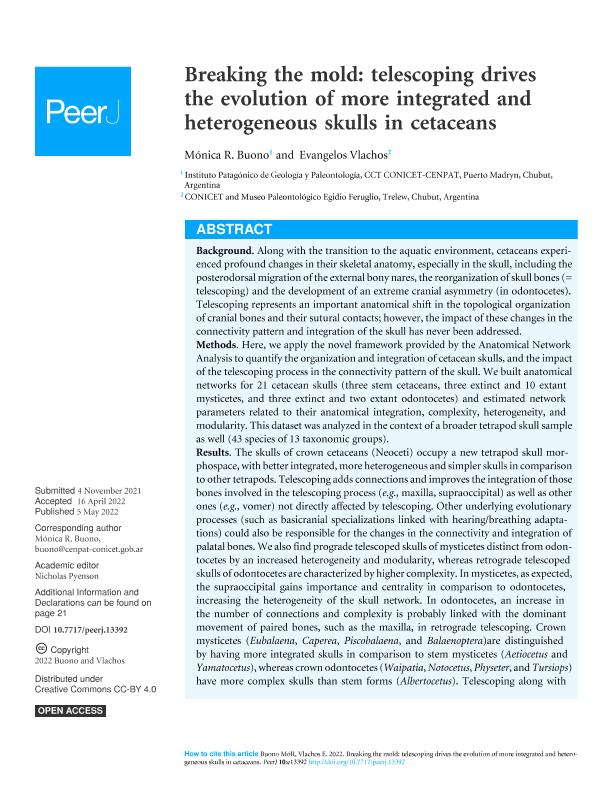Artículo
Breaking the mold: telescoping drives the evolution of more integrated and heterogeneous skulls in cetaceans
Fecha de publicación:
05/2022
Editorial:
PeerJ Inc.
Revista:
PeerJ
e-ISSN:
2167-8359
Idioma:
Inglés
Tipo de recurso:
Artículo publicado
Clasificación temática:
Resumen
Background. Along with the transition to the aquatic environment, cetaceans experienced profound changes in their skeletal anatomy, especially in the skull, including the posterodorsal migration of the external bony nares, the reorganization of skull bones (= telescoping) and the development of an extreme cranial asymmetry (in odontocetes). Telescoping represents an important anatomical shift in the topological organization of cranial bones and their sutural contacts; however, the impact of these changes in the connectivity pattern and integration of the skull has never been addressed. Methods. Here, we apply the novel framework provided by the Anatomical Network Analysis to quantify the organization and integration of cetacean skulls, and the impact of the telescoping process in the connectivity pattern of the skull. We built anatomical networks for 21 cetacean skulls (three stem cetaceans, three extinct and 10 extant mysticetes, and three extinct and two extant odontocetes) and estimated network parameters related to their anatomical integration, complexity, heterogeneity, and modularity. This dataset was analyzed in the context of a broader tetrapod skull sample as well (43 species of 13 taxonomic groups). Results. The skulls of crown cetaceans (Neoceti) occupy a new tetrapod skull morphospace, with better integrated, more heterogeneous and simpler skulls in comparison to other tetrapods. Telescoping adds connections and improves the integration of those bones involved in the telescoping process (e.g., maxilla, supraoccipital) as well as other ones (e.g., vomer) not directly affected by telescoping. Other underlying evolutionary processes (such as basicranial specializations linked with hearing/breathing adaptations) could also be responsible for the changes in the connectivity and integration of palatal bones. We also find prograde telescoped skulls of mysticetes distinct from odontocetes by an increased heterogeneity and modularity, whereas retrograde telescoped skulls of odontocetes are characterized by higher complexity. In mysticetes, as expected, the supraoccipital gains importance and centrality in comparison to odontocetes, increasing the heterogeneity of the skull network. In odontocetes, an increase in the number of connections and complexity is probably linked with the dominant movement of paired bones, such as the maxilla, in retrograde telescoping. Crown mysticetes (Eubalaena, Caperea, Piscobalaena, and Balaenoptera)are distinguished by having more integrated skulls in comparison to stem mysticetes (Aetiocetus and Yamatocetus), whereas crown odontocetes (Waipatia, Notocetus, Physeter, and Tursiops) have more complex skulls than stem forms (Albertocetus). Telescoping along with feeding, hearing and echolocation specializations could have driven the evolution of the different connectivity patterns of living lineages.
Palabras clave:
ANATOMICAL NETWORKS
,
MODULARITY
,
NEOCETI
,
SKULL MORPHOLOGY
,
TELESCOPED BONES
Archivos asociados
Licencia
Identificadores
Colecciones
Articulos(IPGP)
Articulos de INSTITUTO PATAGONICO DE GEOLOGIA Y PALEONTOLOGIA
Articulos de INSTITUTO PATAGONICO DE GEOLOGIA Y PALEONTOLOGIA
Articulos(SEDE CENTRAL)
Articulos de SEDE CENTRAL
Articulos de SEDE CENTRAL
Citación
Buono, Mónica Romina; Vlachos, Evangelos; Breaking the mold: telescoping drives the evolution of more integrated and heterogeneous skulls in cetaceans; PeerJ Inc.; PeerJ; 10; 5-2022; 1-25
Compartir
Altmétricas




